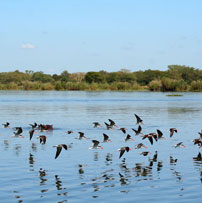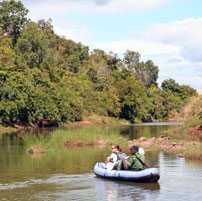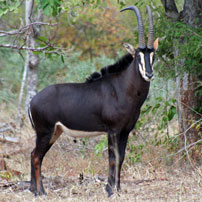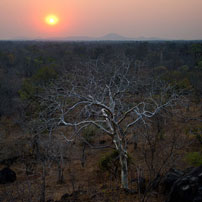 Malawi has long been known for its friendly peoples, relaxed atmosphere and lakeshore retreats. There have always been wildlife viewing opportunities, but historically they have been limited, especially when compared to neighbouring countries like Zambia. But things are changing with old parks being revitalised and it shouldn’t be long before Malawi can offer its own ‘stand alone’ safari experience.
Malawi has long been known for its friendly peoples, relaxed atmosphere and lakeshore retreats. There have always been wildlife viewing opportunities, but historically they have been limited, especially when compared to neighbouring countries like Zambia. But things are changing with old parks being revitalised and it shouldn’t be long before Malawi can offer its own ‘stand alone’ safari experience.
My trip was focused around three particular wildlife regions in the central and southern areas of the country, with a couple of days on the lake and a visit to the tea plantations in the south-east. Whilst the parks are not all offering varied game-viewing yet, I really enjoyed my experiences. The birding was spectacular throughout, with many less common variants of species seen, such as half-collared kingfisher, Bohms bee-eater, dark-chanting goshawk, western banded snake eagle, scimitar-billed wood hoopoe. Rarer species seen included African finfoot, Livingstone’s fly-catcher and Pel’s Fishing Owl. The scenery was always lovely and there were very few vehicles in the parks.
My first stop was Nkhotakota National Park, a vast region o f rolling miombo woodland and riverine forest which is home to the largest population of lions in Malawi. We didn’t see lions, in fact we saw very little in the way of game, but the park was beautiful and very exclusive. We hiked to a spectacular mountain peak for expansive views of the park, floated down the lovely Bua River on inflatable canoes and relaxed in the well run, friendly and tranquil Tongole Wilderness Lodge. Nkhotakota has seen little investment in recent years but is about to have much needed funds released and so the future looks more positive.
f rolling miombo woodland and riverine forest which is home to the largest population of lions in Malawi. We didn’t see lions, in fact we saw very little in the way of game, but the park was beautiful and very exclusive. We hiked to a spectacular mountain peak for expansive views of the park, floated down the lovely Bua River on inflatable canoes and relaxed in the well run, friendly and tranquil Tongole Wilderness Lodge. Nkhotakota has seen little investment in recent years but is about to have much needed funds released and so the future looks more positive.
After a couple of very pleasant days on the lakeshore at Cape Maclear (where we enjoyed quiet sophistication at Pumulani and a Robinson Crusoe experience at Mumbo Island) we arrived at Liwonde National Park, the park that has for a long time been Malawi’s premier game-viewing destination. In many ways Liwonde is thriving and it remains a great place to see elephants in particular. But the situation with predators is surprisingly challenging, especially given the warthog, impala and kudu ‘buffet’ on offer every night along the shores of the Shire River. However, what really struck me was just how beautiful the park is, especially the Shire River. The river is wide, open and slow-moving, full of hippos and crocs and a multitude of birds at every turn. The floodplains are open and teeming with game and there are mountains and hills in the distance, framing the scene. At one point we had several hundred African skimmers flying around our boat, whilst crocs snapped at them on the banks, a pod of hippo watched on with i nterest, spoonbill storks waded in the shallows and a big male baboon sauntered through the scene. It was the best boat cruise I have experienced for several years. Liwonde is entering a phase of re-development with plans to re-introduce certain predators, and with careful and sustained management this park certainly has the potential to be a real gem.
nterest, spoonbill storks waded in the shallows and a big male baboon sauntered through the scene. It was the best boat cruise I have experienced for several years. Liwonde is entering a phase of re-development with plans to re-introduce certain predators, and with careful and sustained management this park certainly has the potential to be a real gem.
Our last couple of days were spent at Majete Wildlife Reserve in the south-west of the country. Here the lower Shire River carves through the Kapichila Hills and is much faster flowing with several rapids and the impressive Kapichila Falls. Majete was a ‘lost park’ 10 years ago, but under the careful management of the private organisation African Parks, the park has been somewhat restored to its former glory. Plenty of game has been re-introduced, including around 10 black rhino and 4 leopard and 4 lions are being introduced in August 2012. The park is predominantly  miombo woodland in the west with more open savannah and riverine woodland in the east along the Shire River and a major tributary that runs through the park, the Mkulumadzi . At the confluence of the two rivers is the lovely Mkulumadzi Lodge, run by Robin Pope Safaris. Birding was spectacular, especially along the Shire, and general game-viewing was good – we saw elephant, buffalo, herds of splendid sable antelope and a black rhino in the evening from a waterhole hide. With Majete shortly becoming a big five reserve, a few more years of careful management should result is an extremely good all round game-viewing experience.
miombo woodland in the west with more open savannah and riverine woodland in the east along the Shire River and a major tributary that runs through the park, the Mkulumadzi . At the confluence of the two rivers is the lovely Mkulumadzi Lodge, run by Robin Pope Safaris. Birding was spectacular, especially along the Shire, and general game-viewing was good – we saw elephant, buffalo, herds of splendid sable antelope and a black rhino in the evening from a waterhole hide. With Majete shortly becoming a big five reserve, a few more years of careful management should result is an extremely good all round game-viewing experience.
